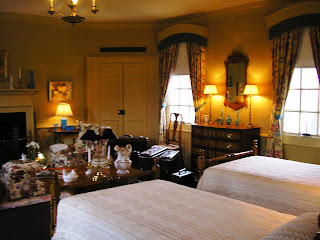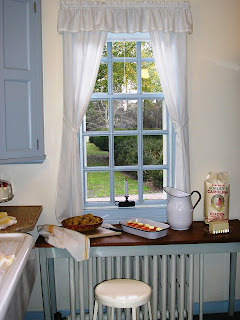At our farewell dinner at the Kings Arm Tavern we tied one on, i.e., the long napkins were tied around our necks as was the colonial custom.
There were 30 participants from 11 states in our group. They were all pleasant and for the most part interesting people. We had a few that were not quite as spry (used canes), but the tour host was careful to make sure they did not get separated from us. The pace of our program was pretty active though; by Thursday when we had the afternoon and evening free to explore on our own, some were glad to slow down.
We had been at Colonial Williamsburg about a decade ago on our own. We stayed 2 nights after visiting the Outer Banks of North Carolina. It was enjoyable, but I really didn't realize how this city fit into the early history of Virginia. Now I do.
Besides our program booklet, we received several handouts from the lecturers and brochures from the plantations we visited.
We had fabulous weather the first full day (70 degrees and sunshine) when we walked the length of Duke of Gloucester Street with a guide provided by Road Scholar. This man had lived in one of the private residences several years ago.
On our second full day we toured Bassett Hall where the Rockefellers lived for several months of the year while reconstruction and restoration of the colonial buildings took place. John D. Rockefeller, Jr. and his wife Abby were the principal investors in the restoration of the historical sector of Williamsburg which had fallen on hard times. In the visitor center of Bassett Hall one can see photos and even news clips of what the area looked like in the 1920s. Gas stations and auto repair shops had replaced many of the private residences. Many of the roads remained unpaved. The Capitol building and Governor's Palace had burned down and were charred ruins. The Williamsburg Foundation promised those living in the remaining houses of the 18th century that they would pay for the building but allow the current residents to remain as tenants if it was allowed to restore at least the façade to its 1770 look. In current colonial Williamsburg, employees reside in some of the buildings which are not open to the public but add ambiance.
Bruton Parish Church, started in 1674, is one of the original buildings from the 18th century though it has been remodeled some. It is still an active Anglican church. We attended a lovely Candlelight Chamber Music Concert of Christmas music on our free night (Thursday). Our group had spent some time with a member of the church one afternoon who told us about the history of the church; she also lectured at our hotel meeting room about religion in the New World throughout all of the original colonies.
I found this gravestone interesting; on 3 sides of the cube, various family member names were etched, but on the 4th side the inscription was for Mammy Sarah, the beloved servant.
The engraving is eroded on many tombstones; some you can't even read anymore.
Our lecturer Anne Conkling is the lady under the window facing the aisle in the cluster of 3 people. One of the wonderful aspects of Road Scholar is its assistive hearing devices. We wear this little receiver around our necks in a pouch and put the ear piece around and into our ear. The lecturer wears a transmitter. While I was wandering the graveyard after the lecture, I could hear her conversing with these people inside. These devices are not only good for those hard of hearing, but as in this case you could wander and take photos and not have to be bunched around a person to hear. Many founding fathers attended this church while in Williamsburg or as students at William and Mary College: George (and Martha) Washington, Patrick Henry, James Madison, Thomas Jefferson are a few.
The grounds and buildings of colonial Williamsburg are "populated" with costumed tradesmen and citizens of the 1770s going about daily life. The tour guides within the buildings also dress of that time.
We were motorcoached to Wren Chapel on the campus of William and Mary College where we were given a private organ concert on a 1760 instrument (not original to the building). There are no foot pedals and a single keyboard.
We had excellent performers throughout the week. We heard the armonica, an invention of Benjamin Franklin's.
Debbie Downs sang wistful black songs of the era and told us stories that were integral to the survival of the slaves and to the culture they knew in Africa; one was based on the Anansi or "Aunt Nancy" story.
Lee Ann Rose came to us as Martha Washington. She told how her friend arranged for her to meet George Washington at a party and once they were deeply engaged in conversation have the other guests leave them alone, though George always told everybody it was a coincidence that he met her. Her Christmastide was in Boston during some of the war years though she would have liked to stay in Virginia. Her friend Mrs. Randolph of Williamsburg had left because her husband was a Loyalist. Her children by her first husband (she had none with George) died at age 2 (a son), age 4 (another son), age 17 (her daughter Patsy). Her adult son Jackie was killed in one of the war battles. She was left with Jackie's two children, her solace after all of her children had died. When she opened it up to questions, someone asked how Patsy died. With tears in her eyes and a tremulous voice she explained how during one of her "spells" Patsy banged her head on the floor. George scooped Patsy up into his arms and shortly after Martha made it up the stairs, Patsy smiled at both of them and expired. In the tavern where we had our farewell dinner the lighting was so poor that I had tried to change the settings of my camera, and failed to reset the mode properly so my photo of Martha turned out as a video, except I thought I was taking a still photo. I was able to get a small still frame to show you.
One of the perks of touring in the Christmas holiday season is the decorations. There is a contest for the private residences to see who can have the most creative/beautiful wreaths. This was an aspect I was really interested in this time around as we were there in the fall before. I was told they can use wire or twine but no glue guns. The materials have to be something that would be available in 18th century Virginia. The irony is that colonial people did not use wreaths to decorate nor have Christmas trees. They put greens on the mantels and doorways, but no decorations on the exterior.
Chowning's Tavern had mini pewter beer steins with cotton representing the foam.
One of our classroom activities was making a clove-studded pomander and arranging greens.
The instructor gave us Clementines. The ribbon is held in place with a straight pin for now because as the fruit dries out it will shrink and the ribbon will have to be tightened and adjusted.
The centerpiece was to have a candle and a pinecone, but we are not allowed to use live flame in our condo at Grace Village so I did not include a candle. Also, there were not enough magnolia leaves for everybody so I only used fir and pine.
Rebecca who led us in doing the decorations had a session earlier in the week where she had us come up in pairs to help her set the table and buffet table for her mistress. Keeping in mind the principles of height and symmetry, the participants selected the dishes to be used and where to place them and then various ones put fruit on the pedestaled dishes.
She proudly showed us her employer family's forks which were a recent addition to the table; Rebecca herself still used only a spoon and knife. She also showed us the shrub glasses which often held syllabub. The syllabub is a popular 18th century dessert consisting of cream treated with an acid, usually citrus juice, and mixed with wine. The different types of syllabubs are based upon their mixing style. Once placed in serving glasses, syllabubs separate into a two-part mixture when the cream rises and the clear liquids sink.
It was almost comical as the Road Scholars were given free reign to change the previous person's work as they were given other fruits to add and almost every one did just that. So much for principles.
It is these everyday items that I enjoy about history; I don't care much about the military activities and the political intrigue.
I was disappointed Saturday morning when our presenter of Colonial foods was iced in after the previous night's sleet and dusting of snow. We decided to head for home rather than stay for the music and wassail toast that was to end at 11 a.m.
The roads were in good condition as we headed west. In Richmond there were 2-3 inches of snow on the ground. Slightly west of Richmond a light steady snow began to fall. The woods and hills were beautiful with the coating of fluffy snow. We had a nice lunch in Staunton at a Mexican restaurant; shortly after entering West Virginia, the snow stopped and we even had a little bit of sun. As we arrived at the Hampton Inn in Gallipolis, Ohio, the desk clerk commented we had stopped just in time as snow was expected to start in the next 10 minutes. Indeed he was right. I was surprised a little about how much snow we had on the ground at home, about 3 inches.
The favorite image in my mind that delights me is of the Tavern Illumination on Thursday night. I took no photo with my simple camera. Our tour guide on Tuesday had answered that the wrought-iron baskets called cressets filled with wood and kindling and hanging on poles in front of the taverns would be involved in a special activity later in the week. Thursday night was the only time we were in the colonial settlement after dark. About 5:30 as we stood in front of Wetherburn's Tavern on the Duke of Gloucester Street, around the corner from the side street came men carrying torches and a corp of about 3 dozen fife and drum players marching. They stopped in front of the tavern and posed for several minutes. The cressets were lit. It was a spectacle I will never forget.
I borrowed this picture from Pinterest.



















































No comments:
Post a Comment